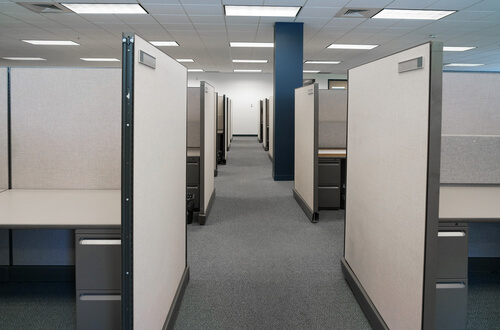It seems that the cubicle is back and, maybe this time, it’s here to stay. But, how did it come to be in the first place? If you’ve been thinking about using office cubicles in your workspace, you may be interested in learning more about their history and what really happened in the office design world.
What’s more, a great number of businesses use office cubicles in a slightly reinvented form. You can now find brand-new pieces and even used cubicles for sale if you want to boost the sustainability of your business in San Diego. But first, take a look at this brief history of the cubicle to understand what role it played in the ever-changing office design.
When was the cubicle invented?
Believe it or not, the cubicle dates back to medieval times when European monks used cubicle-like spaces where they used to copy manuscripts. Renaissance writers also used them and even added curtains to create a more private work area. They reported that this type of space helped them focus on work.

However, the office cubicle as we know it was designed in the 1960s as an alternative to large office areas with desks organized in a factory-line layout. The designer was Robert Propst who created this workspace in an attempt to give employees more freedom. He wanted to create a productive and creative office with dedicated work stations where employees would have enough space to work and store files.
What’s even more surprising is the fact that the initial design focused on the implementation of adjustable desks so that employees could switch between sitting and standing positions. The cubicle office featured a layout in which cubicles were grouped in the central area, while managers and executives had private offices. Unfortunately, this was the beginning of cubicle farms.
When did cubicles become popular?
The cubicle design was officially released in 1967/8 and became extremely popular, but not as their creator intended. Namely, Propst imagined cubicles to be personalized work areas where each employee could have their own personal corner. He wanted to provide workers with a spacious, functional workspace that they could decorate and personalize.
Unfortunately, managers saw this design and layout as an affordable opportunity to cram as many workers as possible in the central area. During the ‘80s and ‘90s, they were the most common type of office because the recession brought many buyouts and mergers, so a great number of employees were crammed into small work areas.
Eventually, the cubicles started to be replaced by open office design in the ‘90s and start-up companies that wanted to make a change. Most importantly, changing office design indicates the evolution of attitudes to work and can help you gain a deeper understanding of the work environment.
Has the cubicle returned?
Employers have realized that the much-loved open design had its own set of drawbacks, which is why many have reconsidered the use of cubicles in the workplace. However, the modern cubicle has a much more flexible and appealing design, promoting office sociability and connectivity.

Therefore, if you’re thinking about going with a cubicle layout, consider following these steps.
- Combine cubicles and open areas for a more balanced work environment.
- Find trendy cubicles with lower partitions and more appealing designs.
- Consider grouping team members together by joining their cubicles.
- Consider your employees’ preferences and provide different options.
The finest used cubicles for sale for enhanced sustainability in San Diego
Here at BOO Furniture, we bring you an opportunity to design a perfectly balanced, productive work area by introducing new or pre-used cubicles. If you want to make your office eco-friendlier and cut some expenses, used cubicles are the perfect solution. Our team is here to help you find what you need, deliver your cubicles within the shortest period of time, and even set them up.
Additionally, we serve the entire San Diego area, so regardless of whether your office is located at the Gaslamp Quarter or somewhere outside the city center, feel free to contact us. Turn your office into a creative hub with our help!
